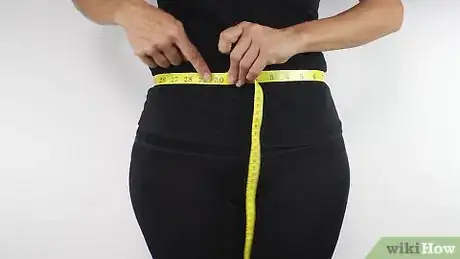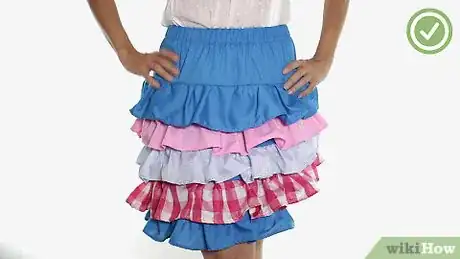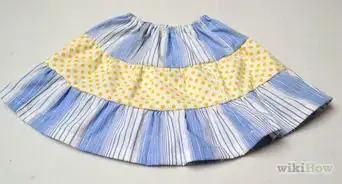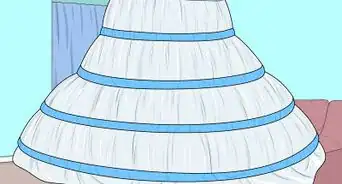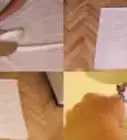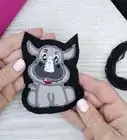X
wikiHow is a “wiki,” similar to Wikipedia, which means that many of our articles are co-written by multiple authors. To create this article, volunteer authors worked to edit and improve it over time.
The wikiHow Video Team also followed the article's instructions and verified that they work.
This article has been viewed 86,749 times.
Learn more...
Layered ruffle skirts are fluffy, feminine, and fashionable. Making your own might seem intimidating at first, but the process is fairly straight-forward.
Steps
Part 1
Part 1 of 4:
Calculating Your Measurements
-
1Measure around your waist. Wrap a tape measure around your waist, keeping the tape measure parallel to the floor and taut against your body. Mark down your waist measurement so that you'll be able to remember it more easily.
- You should measure the area of your body where you want the skirt to sit. Your natural waist is usually a good choice if you aren't sure, but if you want the skirt to sit higher or lower, move the tape measure higher or lower accordingly.
-
2Cut out the elastic. Add 1 inch (2.5 cm) to your measured waist size. Measure and cut out that much elastic.
- The extra inch (2.5 cm) will allow you to overlap the elastic when you sew it into the waistband.
Advertisement -
3Determine your desired length. Figure out where on your body you want the bottom hem to land, then measure from your waist down to that point. Keep the measuring tape perpendicular to the floor, and mark this measurement down.
- Keep in mind that the waistband will add another 1 inch (2.5 cm) to the skirt. When determining your ruffle measurements, subtract 1 inch (2.5 cm) from your desired length before using that figure to calculate your ruffle width.
-
4Decide on your ruffle measurements. Ask yourself how many ruffles you want, then divide your desired length by that amount. That will tell you how wide your finished ruffles need to be.
-
5Measure out your connector and ruffle pieces. Calculate the length of your connector pieces by multiplying your waist size by 1.5. Calculate the length of your ruffle pieces by multiplying the connector length by 2. The width of the connector and ruffle strips will be the same and can be calculated by adding 1 inch (2.5 cm) to the desired width of your finished ruffles.
- If you want to make the ruffles appear even fuller, make the ruffle strips 2.5 times as long as the connector strips.
Advertisement
Part 2
Part 2 of 4:
Preparing the Strips
-
1Cut out your fabric. You'll need one connector piece for each ruffle piece. Cut out the strips of material according to the dimensions you figured out previously.
- If your fabric is not wide enough to cut out a full connector or ruffle strip, you will need to sew two separate, smaller strips together to form one full strip. When the length of both strips are added together, they should equal the total length of your full strip plus 1/2 inch (1.25 cm). Sew the strips together at the short ends with a 1/4 inch (6 mm) seam allowance.
-
2Press the hems. To prevent the connector strips and ruffle strips from unraveling, you will need to hem one long side of each strip using a 1/2 inch (1.25 cm) seam allowance. Fold the material under 1/4 inch (6 mm) and press in place with an iron. Fold the material under by another 1/4 inch (6 mm), masking the raw edge, then press in place again.
- If you have a serger, you can serge the raw edges instead of folding out a hem. Doing so will make the skirt more light-weight.
- Pressing the hems will make it easier for you to sew them in place since the hems will stay put without the use of sewing pins.
-
3Sew the hems in place. Use a straight stitch to sew across each hem. Backstitch at each end to secure your stitches.
- Hemming the strips before you sew them in place will make it easier since the material is still straight and flat at this point.
-
4Gather the ruffles. For each ruffle strip, sew a loose stitch straight across the top long side of the strip. You can do this with a sewing machine or by hand. Pull the tail of thread at the end of the strip to bunch up the material, creating ruffles. Continue gathering the ruffles until the strips shrink down to the size of your connector strips.
- The "top" edge of each strip is the edge directly opposite the hemmed edge.
- You may need to play around with the gathers after you shrink the strip down to even them out along the thread.
- To sew the gathering stitch by hand, simply sew a loose straight stitch across the top edge of the material, making each individual stitch 1/2 inch (1.25 cm) long or so. Leave a long tail at the end to work with for gathering the material.
- To sew the gathering stitch using a sewing machine, set the stitch length to its longest position and set the tension as high as possible. Leave a long tail, then adjust the gathers by pulling on the bobbin thread.
Advertisement
Part 3
Part 3 of 4:
Piecing the Skirt Together
-
1Stitch together the bottom tier. Place the first ruffle piece below the first connector piece, right sides together, and lining them up at the top seam. Pin the pieces together, then sew them in place straight across the top edge. Use a 1/2 inch (1.25 cm) seam allowance.
- Due to the nature of the ruffles, using more pins to hold the pieces together is better than using a few pins. The extra pins help prevent the ruffles from moving around or getting folded in undesirable ways.
- Check the tier when you finish sewing the pieces together to make sure that there are no weird bunches or folds.
- If desired, you can serge away this connecting seam, but doing so is not necessary.
-
2Fold out the tier. Open up the connected strips so that the right sides are now visible. Iron along the seam to flatten the material.
- When spreading out the tier on your surface, the connector piece should be above the ruffle.
-
3Add the second ruffle. Place the next ruffle strip over the connector piece of your bottom tier with the right sides facing out. Place the next connector strip on top of that with the right side of the strip facing in. Line everything up along the top edge, pin in place, then sew straight across the top edge with a 1/2 inch (1.25 cm) seam allowance.
- As before, you should use a lot of pins to help secure the ruffles in place as you sew.
-
4Flip up the top connector piece. Fold the connector piece of your second tier up so that you can see the right side of the material. Iron along the newly created seam to flatten it out.
- This connector piece should now lie above the rest of the skirt.
-
5Add the rest of your ruffles in the same manner. The rest of your ruffled tiers should be sewn to the top of the skirt in the same manner as your second tier.
- Sandwich the ruffle layer in between the attached connector of your previous tier and the new connector strip. The skirt and ruffle strip should face out, but the new connector strip should always face in.
- Pin the layers in place before sewing along the top edge with a 1/2 inch (1.25 cm) seam allowance.
- Flip up the top connector piece and iron out the new seam before moving onto the next layer.
- Repeat as many times as needed until all of your ruffles and connectors have been added.
Advertisement
Part 4
Part 4 of 4:
Forming the Skirt
-
1Sew up the side. Once all of your tiers are sewn together, fold the material in half crosswise with the right sides of the material together and the wrong sides facing out. Pin in place, then sew along the joined edge with a 1/2 inch (1.25 cm) seam allowance.
- Stitch across the edge from the bottom up, stopping just short of the top connector piece. Do not sew the ends of the top connector piece together yet.
-
2Create a waistband pocket. With the skirt inside-out, fold the top connector piece toward you, creating a pocket equal to or a little larger than the width of your elastic. Pin and sew this pocket in place.
- Sew along the open edge of pocket with as small a seam allowance as possible. Do not sew the short ends of the pocket closed.
- Note that you should not need to fold the open edge under the pocket to hide it. This end should already be hemmed if you followed the instructions carefully, so the raw edge is already taken care of.
- Consider ironing out the waistband pocket to help flatten it once you sew it together.
-
3Feed the elastic through the waistband pocket. Attach a small safety pin to one end of your elastic strip and a large safety pin to the other end. Insert the small safety pin and attached elastic end into the waistband pocket, then use your fingers to push the safety pin all the way through the pocket and out through the other side.
- The small safety pin makes it easier to feed the elastic through the pocket, while the large safety pin prevents the other end of the elastic band from working its way into the pocket.
-
4Sew the elastic together. Overlap the ends of the elastic by 1/2 inch (1.25 cm). Pin in place, then sew them together with a needle and thread.
-
5Sew the waistband closed. Tuck the ends of the elastic into the waistband pocket, then bring the raw edges of the pocket together. Stitch them up using a 1/2 inch (1.25 cm) seam allowance.
-
6Try on the skirt. Turn the skirt right-side out again, then slip it on and check yourself out in a mirror. The skirt should fall out to your desired length and the elastic should hold it snug against your waist.
- This step completes the process.
Advertisement
Things You'll Need
- Light-weight fabric (cotton, linen, knits, satin, etc.)
- Elastic, 1/2 to 1 inch (1.25 to 2.5 cm) wide
- Coordinating thread
- Tape measure
- Sewing machine
- Sewing pins
- Sewing needle
- Scissors
- Iron
- Ironing board
- Small safety pin
- Large safety pin
References
About This Article
Advertisement
